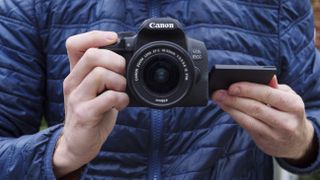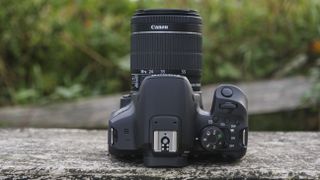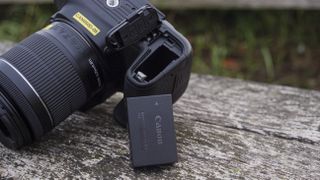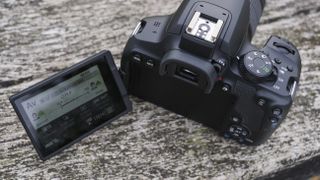Two-minute review
The Canon EOS Rebel T8i (known as the EOS 850D outside the US) is that rare beast – a new DSLR. We don’t often get to test news DSLRs these days, especially at this entry-level price point. And only once we get one in do we see just how little progress or innovation there has been.
In terms of technology and features, the Canon EOS Rebel T8i / EOS 850D feels a few steps behind the best beginner mirrorless cameras. Tellingly, rival DSLRs the Nikon D5600 and Pentax K-70 are both four years old now.
Yes, this a very modest update of the three-year-old Canon EOS Rebel T7i / EOS 800D, with the most notable addition being 4K video. And in reality, the 4K video mode is hindered by some big limitations.
Still, as an entry-level DSLR, the Canon EOS Rebel T8i / EOS 850D is a very capable and comfortable shooter. It’s physically larger than some rival DSLRs and mirrorless cameras, but it is hardly unwieldy at 515g. The build quality isn’t the best either, but the button layout is very considered and the LCD screen handles really well.
In comparison to its predecessor, there simply isn’t enough change here to merit the greater outlay. Make additional comparisons to today’s mirrorless cameras, and it feels like technology in the EOS Rebel T8i / EOS 850D is stunted.
That ‘headline’ inclusion of 4K video to bring this camera up to speed with (and set it apart from) older rival DSLRs is, in reality, extremely limited thanks to a significant crop factor and the loss of phase detection autofocus. If video is important to you, we’d go for a similarly-priced mirrorless alternative like the Sony A6400.
To set the EOS Rebel T8i / EOS 850D apart, we feel that Canon should have majored more in the areas where a DSLR holds the upper hand over mirrorless cameras; better battery life and an optical viewfinder. The viewfinder display is a let down and the battery unit is small, while the camera’s performance dips in live view mode.
Does all this make the EOS Rebel T8i / EOS 850D a bad camera? Not at all. It’s still easy to use and competitive with a 24.1MP sensor, rapid and reliable Dual Pixel AF, a polished vari-angle touchscreen and 7fps continuous shooting. If you still prefer DSLRs to mirrorless cameras, this is a good all-rounder for photography.
Canon EOS Rebel T8i / EOS 850D release date and price
The Canon EOS Rebel T8i / EOS 850D is available to buy now in black. It costs $749.99 / £839.99 body-only (around AU$1,580) or $899.99 / £929.99 (around AU$1,730) with the 18-55mm f/4-5.6 IS STM kit lens (28-88mm equivalent).
There are other kits available on the Canon website and the camera was first announced in early 2020, so if you shop around there could be better deals elsewhere.
Build and handling
- Plastic body, but has a comfortable grip
- Small optical viewfinder with 0.82x magnification
- Bright, polished 3.0in vari-angle touchscreen
DSLR-style cameras are almost always really comfortable to hold and the EOS Rebel T8i / EOS 850D is no exception. It has a generous handgrip and there’s something about this form factor that feels really functional.
It’s also a relatively dinky camera for a DSLR, weighing a mere 515g with card and battery inserted. Not all DSLR cameras are unwieldy. We had the standard 18-55mm f/3.5-5.6 kit lens for this test and it’s a lightweight combination.
The body is obviously plastic. This camera may sit above the entry-level Canon EOS Rebel SL3 / EOS 250D, but its build quality is similar and we wouldn’t want to bash the EOS Rebel T8i / EOS 850D around a lot or expose it to adverse weather. The card door feels especially flimsy.
Held alongside the larger Canon EOS 90D, which is also plastic, there is a slight difference in quality, namely the weight and the feel of the faux leather grips.
Like its predecessor, a beginner-friendly ‘Guided’ menu system is active by default, providing instructions on what the various shooting modes represent and how to use them.
For instance, in aperture priority mode (‘Av’) the effect of aperture in relation to background blur is explained. There are additional tips to achieve background blur too, like moving closer to the subject or further away from your background.
Once you’ve outgrown those instructions, the display can be switched to the ‘Standard’ setting, which is Canon’s familiar menu display. In this mode, access to manual exposure controls is more straight forward, which is a sensible bit of product design.
Controls wise, there is a top dial and rear control wheel for exposure adjustments and autofocus area selection, plus a smattering of small buttons for controls like ISO and the autofocus mode.
The on/off switch is built into the shooting mode dial and also features the video mode setting. The position of this switch near the right thumb feels more logical than the Canon EOS 90D, where the dial and switch is on the left side.
Two doors are built into the faux leather on the left side of the camera, containing ports for a microphone, wired remote, USB and mini HDMI accessories. As we’d expect for an entry-level camera, there is no headphone jack.
With a relatively modest feature set, the camera only offers a single SD card slot compatible with the slower UHS-I card type. We used a best-in-class UHS-I U3 card for this test, which coped with continuous high speed shooting and video recording.
Despite a tiny 1,040mAh battery, the EOS Rebel T8i / EOS 850D boasts an excellent 800-shot battery life when using the optical viewfinder. It’s a clear advantage over mirrorless cameras. However, switch to live view mode and the battery life is reduced to 310 shots.
So, you’d naturally keep the LCD screen off and make the most of that better battery life, right? Well, sadly the viewfinder display is quite small and over time we naturally leant towards using the excellent vari-angle touchscreen instead to view and compose images and navigate the menu.
The optical viewfinder isn’t too bad and offers a 0.82x magnification, but it doesn’t fill your vision like on a full-frame DSLR. Rivals like the Pentax K-70 and Nikon D5600 also both boast bigger displays. The EOS Rebel T8i / EOS 850D display is also 95% coverage, meaning you don’t see the outer edges of your pictures. In some scenarios, there is also a twinge of chromatic aberration in the display corners.
In our opinion, the EOS Rebel T8i / EOS 850D handles better in its live view mode, especially if you are making regular changes to camera settings. Certainly you’ll want to switch to the ’Standard’ display mode after using the camera for a while to gain quicker access to the settings.
Another factor to consider on battery life is that many mirrorless cameras offer on-the-go USB charging, enabling you to keep the battery topped up. Overall, the key selling points that the EOS Rebel T8i / EOS 850D should have over mirrorless rivals are, in reality, less advantageous after all.
We should, however, praise this camera’s lovely 3.0in vari-angle touchscreen. It’s nothing new, but it’s still great. The touchscreen response, the bright display, the comprehensive function for focusing, menu navigation, image capture and playback. It’s very polished indeed.
Overall, between the two in-camera menus and the LCD/viewfinder displays, plus its logical button layout, the EOS Rebel T8i / EOS 850D handles well for beginners and those advancing their skill level.
Performance
- Speedy, reliable Dual Pixel phase detection AF
- Decent 7fps burst shooting (with the mechanical shutter)
- No Dual Pixel AF in 4K video shooting
One thing that the EOS Rebel T8i / EOS 850D has in its favor is a rapid and reliable autofocus system. It’s Canon’s famous Dual Pixel phase detection AF that works very well for both photography and video.
In the EOS Rebel T8i / EOS 850D’s viewfinder mode, it’s still a 45-point AF array, and all of those points are the more sensitive ‘cross-type’. Switch to the live view mode and it’s a 143-point array that covers a broader area of the frame with eye AF chucked in, just like in the Canon EOS M50.
There is a choice between single shot, mixed action and full action AF modes, with an additional choice of the AF area, including single point, zone (small or large), plus auto. We found the small zone AF mode works a treat for general action and in viewfinder mode the zone area can be quickly selected using either dial, or by touch in live view mode.
Autofocus behavior is different in the 4K video mode to Full HD video and that’s because you lose Dual Pixel phase detection AF. Instead, it’s the less effective contrast detection AF which is more prone to focus hunting. It’s a further sour point to 4K video here.
With the five-axis digital image stabilization active in its standard mode, smooth-looking handheld panning shots are easy to get. In the ‘Enhanced’ mode, stabilization performs impressively well when walking with the camera in-hand, although it is no gimbal.
Remember, there is a significant crop factor introduced with stabilization active, so 4K selfie vlogging is not really an option.
For photography, many of Canon’s lenses offer optical stabilization, including the 18-55mm kit lens. We tried this kit lens at various focal lengths and in general found stabilization to be effective to around 3.5EV. The effectiveness of stabilization does depend on the lens, so you might have a different experience.
We tested the high-speed continuous shooting mode which, as already mentioned, has a rate of 7fps using the mechanical shutter and 7.5fps when using the electronic shutter.
In either shutter mode, using a UHS-I U3 card we managed around 55 raw and JPEG shots before the camera stopped, with a wait time of around 15 seconds to buffer all of those images for the camera to fully function again. That’s a reasonable performance, making the EOS Rebel T8i / EOS 850D a decent sidekick for action shots.
Image quality
- The 18-55mm kit lens is a little soft
- 4K videos at 25fps, but with up to a 2.2x crop
- In-camera RAW image processing
There are no surprises with the image quality of the Canon EOS Rebel T8i / 850D – it’s the same sensor and processor pairing as the Canon EOS M50. This a capable shooter, capturing crisp and colorful images in good contrast light.
It’s good to see 4K video and the higher resolution does result in a crisper image than in Full HD. Sadly, it is tricky to achieve a wide-angle view because of the crop factor, but on the flip-side you do get a more telephoto image which could suit your preferred video style.
Color vibrancy is subjective, but we are fans of Canon’s standard color setting. Color rendition is particularly good in JPEG images, though if you prefer a vibrant, saturated effect you may wish to change to the appropriate Picture Style.
Image quality in low light is also very good, with the EOS Rebel T8i / EOS 850D able to produce sharp images all the way up to ISO 6400. Fine grain begins at ISO 1600 but only when viewing images at 100% and it’s completely acceptable, while the adverse impact of noise is mainly seen through color desaturation from ISO 3200 and up.
In general, we would happily use ISO 6400 while avoiding the higher sensitivity settings where luminance (and chroma noise in JPEGs) is more obvious.
There are still better rivals out there in low light scenarios, namely the Pentax K-70, Nikon D5600 and Fujifilm X-T30, all of whom also offer a wider dynamic range in a single image. If you have an overly bright or dark image, there is not quite the same scope for recovering detail in the EOS Rebel T8i / EOS 850D.
To get the most out of the image sensor, we recommend a different lens to the 18-55mm f/3.5-5.6 kit lens that we used during this test. It is both soft and displays chromatic aberration in certain scenarios.
Thankfully, being part of the Canon EF series means there are plenty of better lenses to choose from. If you’re new to the Canon system, it is still worth collecting the 18-55mm lens because it adds so little cost when bought as part of a kit.
Should I buy the Canon EOS Rebel T8i / EOS 850D?
Buy it if…
You’re still a fan of DSLRs
Mirrorless cameras may now dominate when it comes to new launches, but DSLRs like the EOS Rebel T8i / EOS 850D do still bring some advantages like battery life (in viewfinder mode) and handling. If those are important to you, it is still an option. Thought it’s worth bearing in mind that this camera handles better in live view mode, its traditional benefits feel somewhat redundant.
You already have some EF lenses
The EOS Rebel T8i / EOS 850D doesn’t have enough new features to be considered a worthy upgrade from its predecessor, but if you have an older Canon DSLR with some EF lenses, then it might be worth considering. Particularly as they could help fully unlock this camera’s talents, unlike the slightly soft 18-55mm kit lens.
You need stellar DSLR autofocus
One of the EOS Rebel T8i / EOS 850D’s best features is undoubtedly its Dual Pixel phase detection AF system. It’s fast, reliable and works very well for both photography and video. Though it’s worth bearing in mind that only inferior contrast detection AF is available when shooting 4K video.
Don’t buy it if…
You want to shoot lots of 4K video
It might be new, but this camera is still a relic from a time when Canon cameras had serious restrictions on their 4K video shooting. Shoot at that resolution, and you’ll get the less effective contrast detection AF, plus a pretty big crop if you turn on digital image stabilization. Handheld 4K vlogging, then, isn’t really an option, but it’s certainly a capable performer at Full HD.
You need a compact, travel-friendly camera
It might be pretty small and light for a DSLR, but mirrorless cameras like the Fujifilm X-T30 offer similar performance (and better dynamic range) than this camera in far smaller packages. Lenses can negate this size advantage to an extent, but if you’re planning to travel light, a mirrorless camera will be much more portable.
You’re looking for a DSLR bargain
Right now, there are certainly better value DSLRs available than the EOS Rebel T8i / EOS 850D. While its price may come down, it’s a little bit pricey considering the its predecessor, the EOS Rebel T7i / 800D, is currently available for around 33% less. Recent mirrorless cameras like the Fujifilm X-T30 and Sony A6400 are also available for a similar price to this camera, and bring more advanced features.


























